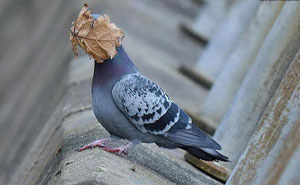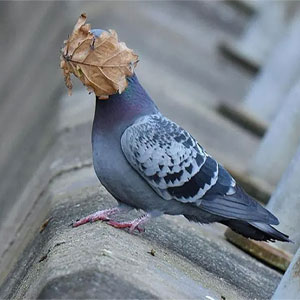Cats and trees go together like Fall and pumpkin spice lattes—you can hardly imagine one without the other. Whether it’s a tiny kitten clawing its way up a birch tree’s bark or a giant floof bounding from branch to branch atop an ancient oak tree, we can’t help but admire felines in trees.
In fact, some cats look so snug and at home perching in treetops that it made us wonder if they might have secretly been raised by birds. Scroll down for Bored Panda’s collection of birdlike cats in trees, upvote your favorite photos, and check out our previous post about cattos sleeping in trees right here.
Bored Panda wanted to learn more about why cats enjoy climbing trees so much and why they tend to get stuck in treetops, so we reached out to cat behaviorist Ingrid Johnson.
This post may include affiliate links.
While both are members of the genus phatcollaredgatos and share slothful arboreal behavior patterns, the Australian Koala, which eats shoots and leaves, should not be mistaken for the far more deadly Eurasian Koala (pictured), which eats, shoots, and leaves.
According to cat behaviorist Ingrid, cats seek height for a lot of different reasons. What's more, for an outdoor cat or an indoor-outdoor cat, those reasons could even save their life. "Height provides comfort and security and the ability to survey a lot of territory from a single vantage point. Climbing a tree or a cat condo for our indoor only friends provides a sense of safety," she explained.
"Height also creates more usable territory and allows cats to avoid conflict with other cats. So an outdoor cat may climb a tree to escape an attacker (a rival neighborhood cat or a dog!), the same reason an indoor cat might bolt up a cat tree or perch on top of the kitchen cabinets if appropriate climbing places are not provided."
Cats can also chase their prey, like a squirrel, chipmunk, or a bird, up a tree. But cats also climb to hang out, to take a nap, and for fun! "They condition their claws and muscles by scratching and climbing. We call these 'feel good' behaviors. In fact, many indoor cats never get a chance to condition/hone their back claws because few cat condo companies provide a straight vertical pole to climb."
She continued: "Which is exactly why my husband, Jake and I provide the market with a six foot, wall mounted scratch pole. There are virtually none on the market, we have multiples of these in our home and our cats climb them regularly. It is a great way to mimic a tree for an indoor cat. Just always be sure to provide a way for them to get down."
Ingrid confirmed to Bored Panda that cats have a lot more trouble climbing out of trees than up them.
"Cats are not squirrels," she said. "If you take a look at a cat's nail, it is hook shaped, made for climbing, but they cannot come straight back down the tree. They would have to come down backwards, jump down, or descend using a series of branches like stairs."
When a cat pursues its prey or is being chased, it can climb up a very tall trees that don't have any low-lying branches. And just like that, they're stuck.
"This is precisely why, when creating vertical space for your cats in your own home, that we are sure to not create dead end spaces as they can be points of aggression in multi-cat homes and that we also create a way for them to descend, especially if we have provided them with a tall scratch pole."
Cats are built for climbing. Lots of climbing. They have powerful hind legs and strong backs, so it’s no surprise that when they see a tree, they’ll instinctively want to go as high up as they can.
What’s more, there are certain advantages to perching in a tree. When you’re higher up, you can spot your dinner from much further away while they remain unaware. (Let’s keep that in mind the next time we want to ambush an ice cream truck.)
However, climbing up trees isn’t just an offensive move; it can be a defensive tactic, too! Cats aren’t at the top of the food chain, so they can fall victim to other wild animals or the neighborhood doggos. Being up high means cats feel safer, more relaxed, and can taunt their would-be predators as much as they like. Unless their pursuers can climb trees, too!
Unfortunately, what makes cats great at climbing up trees makes them terrible at coming back down to the solid ground.
“A cat in a tree may have trouble coordinating their hind and front feet when they try to back down. It’s just not a movement cats normally do,” feline ethologist from Maryland, Susan Bulanda, told Pet MD. That’s why cats most often jump from high places instead of climbing down.
Despite how much cats seem to enjoy trees, some of them really are notoriously bad at climbing down. Some might get scared. Others might get confused.
I’ve never had to rescue a cat from a tree before, but I’m pretty sure some of you Pandas have been everyday superheroes before—let us know if you’ve ever rescued a trembling catto before and how it went.
When I was a child, my family rented a granny flat behind a house ( we were migrants to Australia), and in front there was a cat tree, as an 11 year old, it was the most amazing experience. This was in 1965.
I have a cat that we rescued from starving/freezing to death on the edge of winter in a park near our home. When we got him, he was the tiniest kitten and we often joke that he was raised by the Canadian geese who are prevalent in that area. Evidence for the claim: He squawks when he's hungry, he doesn't understand that our other cat's hissing is a threat display, and he loves bread.
PS. I understand that technically they are "Canada geese" but they are terrible and I refuse to do them the honour of mangling the English language just for them.
Load More Replies...My first cat, Shiraz, was a solidchunk under his fluff. He was also very friendly to everyone, including a neighbourhood cat that we called Red. We once saw the two of them on the garden wall, next to a small tree. Red shot up the tree, looked down at Shiraz, who was watching, then easily climbed down and waited. Shiraz climbed the tree, less gracefully, then started trying to make his way down. He was a lot less confident and graceful, though he got himself out OK in the end, and joined Red back on the wall. I swear Red had dared him to climb the tree.
Same story here. I had an adult cat who was bottle feed and apparently didn't learn how to be a cat. Later, he was introduced to a skilled adult momma cat who proceeded to reach him how to climb, balance, and jump over tall objects. I'm sure she taught him many other things but these are just what I personally witnessed. Before her lessons he treated trees like velcro cling walls.
Load More Replies...When I was a child, my family rented a granny flat behind a house ( we were migrants to Australia), and in front there was a cat tree, as an 11 year old, it was the most amazing experience. This was in 1965.
I have a cat that we rescued from starving/freezing to death on the edge of winter in a park near our home. When we got him, he was the tiniest kitten and we often joke that he was raised by the Canadian geese who are prevalent in that area. Evidence for the claim: He squawks when he's hungry, he doesn't understand that our other cat's hissing is a threat display, and he loves bread.
PS. I understand that technically they are "Canada geese" but they are terrible and I refuse to do them the honour of mangling the English language just for them.
Load More Replies...My first cat, Shiraz, was a solidchunk under his fluff. He was also very friendly to everyone, including a neighbourhood cat that we called Red. We once saw the two of them on the garden wall, next to a small tree. Red shot up the tree, looked down at Shiraz, who was watching, then easily climbed down and waited. Shiraz climbed the tree, less gracefully, then started trying to make his way down. He was a lot less confident and graceful, though he got himself out OK in the end, and joined Red back on the wall. I swear Red had dared him to climb the tree.
Same story here. I had an adult cat who was bottle feed and apparently didn't learn how to be a cat. Later, he was introduced to a skilled adult momma cat who proceeded to reach him how to climb, balance, and jump over tall objects. I'm sure she taught him many other things but these are just what I personally witnessed. Before her lessons he treated trees like velcro cling walls.
Load More Replies...
 Dark Mode
Dark Mode 

 No fees, cancel anytime
No fees, cancel anytime 



































































































































